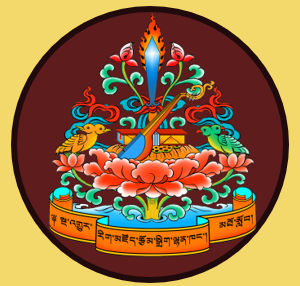Buddha Shakyamuni, born as Siddhartha Gautama in the Shakya clan of the Kapilavastu kingdom in present day Nepal, is one of the most iconic world leaders, who skilfully served sentient beings, fostering both temporal and ultimate benefits. For this, he first awakened the aspiration to enlightenment, practised austerities and completed the twofold accumulation of merit and wisdom. He then awakened into true buddhahood and finally started turning the wheel of the Dharma. He taught the four Noble Truths in Varanasi, the doctrine of prajnaparamita at Vulture Peak, and the Lankavatara Sutra and many other tantra teachings in various indefinite places of gods and nagas. Moreover, he taught the teachings on the ten virtues in Rajgir, the twelve links of interdependence in Magadha, and so on. All these teachings consist of 84,000 methods to attain true peace and freedom from suffering. It is said that we all have 84,000 different types of negative emotions, so these teachings were said to be taught as antidotes to those emotions, which are the primary sources of taking rebirth in samsara, obstructing us from attaining enlightenment.
The most extensive version of these teachings is classified into 84,000 divisions, the medium one into twelve, and the shortest version into three (commonly known as Tripitaka). These teachings are also categorized into ‘sutra and tantra’ or ‘lower and higher vehicles’. Several centuries after the Buddha’s parinirvana, the teachings from the first turning of the wheel of Dharma were written down in Pali and preserved in Sri Lanka. The teachings of the second and third turning of the wheel of the Dharma—which comprise what is now known as the Mahayana, or Great Vehicle—were composed primarily in Sanskrit and other local Indian languages. Eventually the canon, which also included early tantras, was translated into Chinese, Tibetan, Mongolian, and other Asian languages. In Tibetan, the teachings are called ka (words of the Buddha).The Tibetan translation of the words of the Buddha is now known as the Kangyur (translated works of the Buddha). Currently, the words of the Buddha are also being translated into English under the auspices of the organization called 84,000: Translating the Words of the Buddha.
The Kangyur contains the teachings of the Buddha himself. However, some teachings like the Heart Sutra (prajnaparamita hridaya sutra) are also counted as ka, though they are not the Buddha’s own words. Hence, some teachings by the Buddha’s close disciples like Shariputra, Muadgalyayana and others are also included in the Kangyur.
This collection of texts was translated into Tibetan chiefly by translators like Vairochana, Kawa Paltseg, Chogro Lui Gyaltsen, Zhang Yeshe De (commonly known as ‘Ka-Chog-Zhang Sum’) and others in the late eighth or early ninth century under the patronage of King Trisong Deutsen. All of the teachings in the Kangyur can be condensed into the Vinayapitaka, Sutrapitaka and Abhidharmapitaka sections, collectively called the ‘Tripitaka’. Vinaya teachings mainly give advice for the moral conduct of monks and nuns by relating various incidents at the time of the Buddha as the bases for the precepts. Similarly, the Sutra section records the conversations between the Buddha and bodhisattvas on various topics of the Dharma. The Abhidharma reveals details about the formation of the outer world and mind, starting from the unit on material phenomena and mind, and their behaviours. In general, Vinaya, Sutra and Abhidharma mainly emphasize moral conduct, meditative concentration and wisdom respectively. This collection usually numbers about 108 large, multi-text volumes.
There are about twelve different Kangyurs named after their different places of publication, like Derge Kangyur, Lhasa, Narthang, Cone, Peking, Urga, Phurdrak, Stog, and so forth.
Later, many accomplished and learned Indian Buddhist masters composed commentaries on these teachings, which are termed ten-chö (commentaries on the words of the Buddha). The Tibetan translations of these teachings is collectively called the Tengyur (translated works of the commentaries).
The Tengyur contains all the commonly accepted commentaries by Indian Buddhist masters on the words of the Buddha. These texts were written as commentaries to the Buddha’s canon, such as commentaries on madhyamika by Nagarjuna and his followers like Chandrakirti and others, abhidharma by Vasubandhu, pramana by Dignaga, prajnaparamita and tathagatagarbha by Maitreya and Asanga, vinaya by Gunaprabha and Shakyaprabha, and so on. It also contains commentaries by the followers of the Buddha during his time such as Ananda, Shariputra, Maudgalyayana and others. It can be classified into various categories, such as collections of eulogy, tantra, sutra, philosophy, epistemology, logic, and so forth. The texts were originally composed in the Pali and Sanskrit languages. Later, they were translated into Tibetan by the abovementioned translators as well as the later translators like Rinchen Zangpo, Loden Sherab and others. It takes up around 224 to 228 volumes according to different publications.
Translation of the ka and ten-chö into the Tibetan language was mainly due to the kindness of Shantarakshita, Guru Padmasambhava and King Trisong Deutsen, popularly known in Tibet as ‘Khen-Lob-Choe Sum’ (the Scholar, the Teacher and the Dharma king), and their disciples. During the translation process, the Tibetan translators first translated the texts and then proofread them with Indian scholars (commonly known as mahapanditas) to fix the meanings from their source languages into Tibetan. It is also said that all the translators were accomplished beings blessed by Manjushri, the Lord of Wisdom. They were able to translate the terms and languagesflawlessly without any difficulties. Therefore, the followers of Tibetan Buddhism consider these teachings to be greatly blessed and show them immense respect.
By Phuntsho Tobjur
6th Year, NNI



